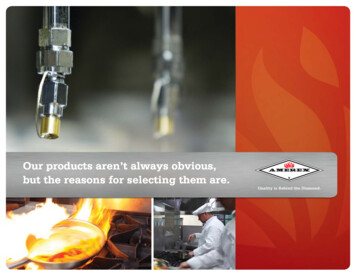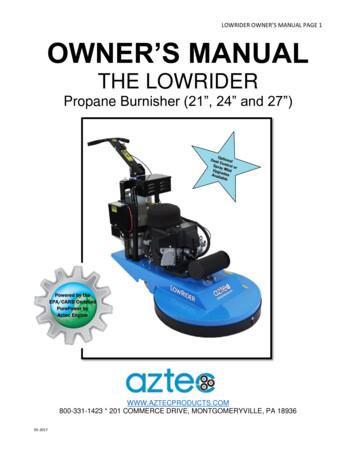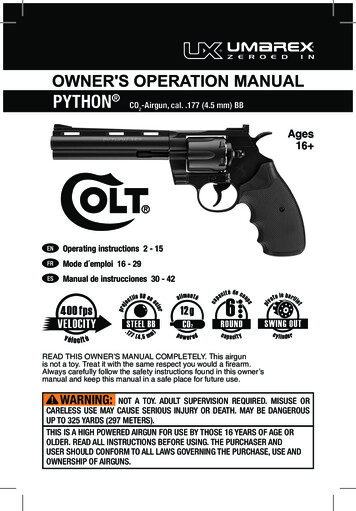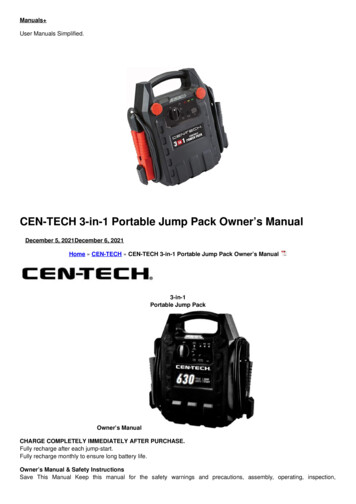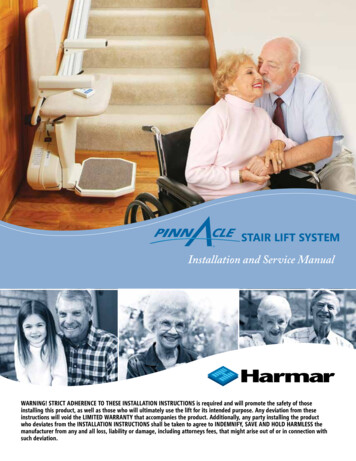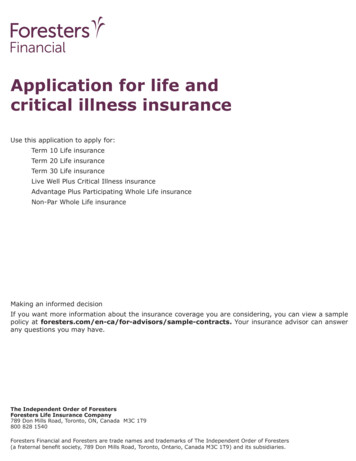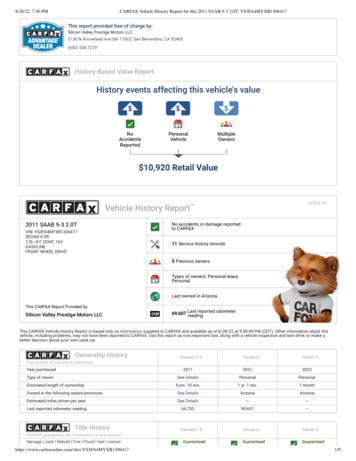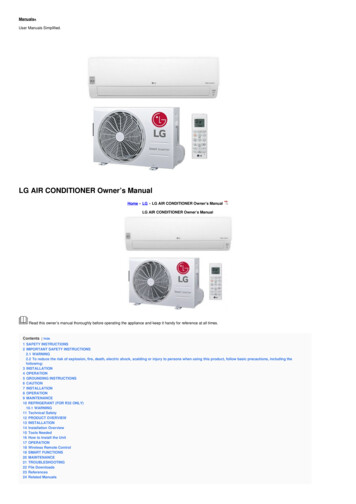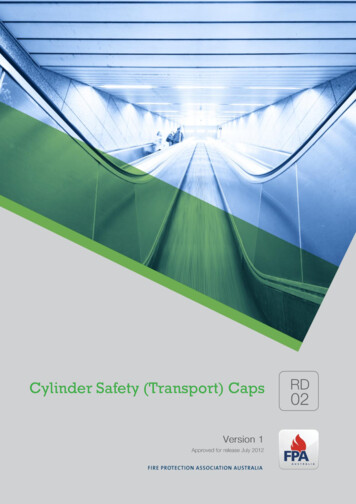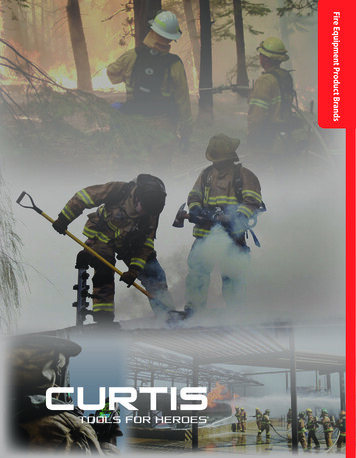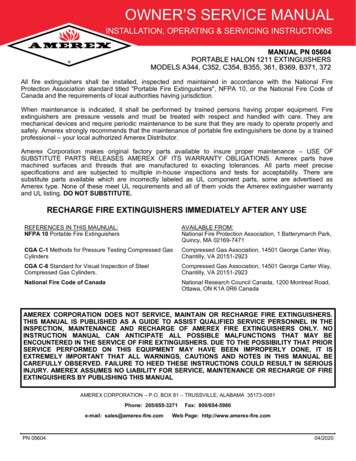
Transcription
OWNER’S SERVICE MANUALINSTALLATION, OPERATING & SERVICING INSTRUCTIONSMANUAL PN 05604PORTABLE HALON 1211 EXTINGUISHERSMODELS A344, C352, C354, B355, 361, B369, B371, 372All fire extinguishers shall be installed, inspected and maintained in accordance with the National FireProtection Association standard titled "Portable Fire Extinguishers", NFPA 10, or the National Fire Code ofCanada and the requirements of local authorities having jurisdiction.When maintenance is indicated, it shall be performed by trained persons having proper equipment. Fireextinguishers are pressure vessels and must be treated with respect and handled with care. They aremechanical devices and require periodic maintenance to be sure that they are ready to operate properly andsafely. Amerex strongly recommends that the maintenance of portable fire extinguishers be done by a trainedprofessional – your local authorized Amerex Distributor.Amerex Corporation makes original factory parts available to insure proper maintenance – USE OFSUBSTITUTE PARTS RELEASES AMEREX OF ITS WARRANTY OBLIGATIONS. Amerex parts havemachined surfaces and threads that are manufactured to exacting tolerances. All parts meet precisespecifications and are subjected to multiple in-house inspections and tests for acceptability. There aresubstitute parts available which are incorrectly labeled as UL component parts, some are advertised asAmerex type. None of these meet UL requirements and all of them voids the Amerex extinguisher warrantyand UL listing. DO NOT SUBSTITUTE.RECHARGE FIRE EXTINGUISHERS IMMEDIATELY AFTER ANY USEREFERENCES IN THIS MAUNUAL:NFPA 10 Portable Fire JJJJJJJAVAILABLE FROM:National Fire Protection Association, 1 Batterymarch Park,Quincy, MA 02169-7471CGA C-1 Methods for Pressure Testing Compressed GasCylindersCompressed Gas Association, 14501 George Carter Way,Chantilly, VA 20151-2923CGA C-6 Standard for Visual Inspection of SteelCompressed Gas Cylinders.Compressed Gas Association, 14501 George Carter Way,Chantilly, VA 20151-2923National Fire Code of CanadaNational Research Council Canada, 1200 Montreal Road,Ottawa, ON K1A 0R6 CanadaAMEREX CORPORATION DOES NOT SERVICE, MAINTAIN OR RECHARGE FIRE EXTINGUISHERS.THIS MANUAL IS PUBLISHED AS A GUIDE TO ASSIST QUALIFIED SERVICE PERSONNEL IN THEINSPECTION, MAINTENANCE AND RECHARGE OF AMEREX FIRE EXTINGUISHERS ONLY. NOINSTRUCTION MANUAL CAN ANTICIPATE ALL POSSIBLE MALFUNCTIONS THAT MAY BEENCOUNTERED IN THE SERVICE OF FIRE EXTINGUISHERS. DUE TO THE POSSIBILITY THAT PRIORSERVICE PERFORMED ON THIS EQUIPMENT MAY HAVE BEEN IMPROPERLY DONE, IT ISEXTREMELY IMPORTANT THAT ALL WARNINGS, CAUTIONS AND NOTES IN THIS MANUAL BECAREFULLY OBSERVED. FAILURE TO HEED THESE INSTRUCTIONS COULD RESULT IN SERIOUSINJURY. AMEREX ASSUMES NO LIABILITY FOR SERVICE, MAINTENANCE OR RECHARGE OF FIREEXTINGUISHERS BY PUBLISHING THIS MANUALAMEREX CORPORATION – P.O. BOX 81 – TRUSSVILLE, ALABAMA 35173-0081Phone: 205/655-3271e-mail: sales@amerex-fire.comPN 05604Fax: 800/654-5980Web Page: http://www.amerex-fire.com04/2020
INSPECTING THE EXTINGUISHERThis extinguisher must be inspected at regular intervals (monthly or more often if circumstances dictate) toinsure that it is ready for use. Inspection is a "quick check" that a fire extinguisher is available and is inoperating condition. It is intended to give reasonable assurance that the fire extinguisher is fully charged. Thisis done by verifying that it is in its designated place, that it has not been actuated or tampered with and thatthere is no obvious physical damage or condition to prevent its operation.PERIODIC INSPECTION PROCEDURES(Monthly or more often if circumstances dictate)NFPA 10 Periodic inspection of fire extinguishers shall include a check of at least the following items:1. Located in designated place.2. No obstruction to access or visibility.3. Pressure gauge reading or indicator in the operable range or position.4. Operating instructions on nameplate and facing outward.5. Tamper seal not broken or missing.6. Examination for obvious physical damage, corrosion, leakage or clogged nozzle.7. Fullness determined by weighing or hefting.MAINTENANCENFPA 10 Extinguishers shall be subjected to maintenance at intervals of not more than 1 year, at the time ofhydrostatic test or when specifically indicated by an inspection or electronic notification. Maintenanceprocedures include a thorough examination of the basic elements of a fire extinguisher:1. Mechanical parts2. Extinguishing agent or cartridge of cylinder operated extinguishers, pump tanks and certain types ofstored pressure extinguishers3. Expelling meansNOTE: Stored pressure halon 1211 extinguishers do not require an internal examination of thecylinder or examination of the agent during annual maintenance, but shall receive athorough external examination.Maintenance is a thorough examination of the fire extinguisher. It is intended to give maximum assurance thata fire extinguisher will operate effectively and safely. It includes a thorough examination for physical damageor condition to prevent its operation and any necessary repair or replacement. It will normally reveal ifhydrostatic testing or internal maintenance is required.MAINTENANCE – SERVICE PROCEDURE1. Clean extinguisher to remove dirt, grease or foreign material. Check to make sure that the instructionnameplate is securely attached and legible. Inspect the cylinders for corrosion, abrasion, dents or welddamage. If any of these conditions are found and you doubt the integrity of the cylinder, hydrostaticallytest to factory test pressure, using the proof pressure method in accordance with CGA C-1 and C-6 andNFPA 10. See proper method of depressurizing and reclaiming Halon 1211 in SIX-YEARMAINTENANCE/RECHARGE PROCEDURE.Note: When cleaning, avoid use of solvents around the pressure gauge. They could seriouslydamage the plastic gauge face.2. Inspect the extinguisher for damaged, missing or substitute parts. Only factory replacement parts areapproved for use on Amerex fire extinguishers.PN 0560404/2020
3. Remove and check pull pin for freedom of movement. Replacement if bent or if removal appears difficult.4. Check the date of manufacture printed on the extinguisher label (nameplate). All stored pressure Halon1211 extinguishers must be hydrostatically (proof pressure) tested every 12 years.5. Visually inspect the pressure gauge:a. If bent, damaged or improper gauge, depressurize and replace.b. If pressure is low or high and temperature/pressure relationship has been ruled out:1. If pressure is low, check for leaks.2. If over pressurized (overcharged), depressurize the extinguisher and follow recharge instructions.6. Inspect discharge lever for any dirt or corrosion which might impair freedom of movement. Inspectcarrying handle for proper installation. If lever, handle or rivets are damaged, replace with proper Amerexpart(s).7. Check weight of extinguisher and compare to proper weight specified on extinguisher nameplate. Ifdiscrepancy is noted, remove nozzle or hose assembly and follow Complete Maintenance/RechargeProcedure for recharging.8. Remove nozzle or hose and horn assembly. Inspect nozzle, hose gasket (o-ring), hose and hornassembly for damage – replace as necessary. Blow air through hose and horn or nozzle to insurepassage is clear of foreign material and replace component parts as necessary.9. Inspect the valve assembly for corrosion or damage to hose thread connection. Replace valve assemblyor component parts as necessary following the proper recovery and recharge procedures. If valve removalis necessary, complete all steps in the Complete Maintenance/Recharge Procedure.10. Install nozzle or hose and horn assembly.11. Install new tamper seal and record service data on the extinguisher inspection tag.12. Replace the extinguisher on the wall hanger making sure that it fits the bracket properly – replace thebracket if necessary.COMPLETE MAINTENANCE – SIX YEAR TEARDOWNNFPA 10 Every six years, stored pressure extinguishers shall be emptied and subjected to the applicablemaintenance procedures. When the applicable maintenance procedures are performed during periodicrecharging, the six year requirement shall begin from that date.WARNING:a. Before attempting to devalve the extinguisher for Maintenance, Hydrotest or Recharging be sure that itis completely depressurized. Halon 1211 generates a vapor pressure of 22 psi @70 F. NEVER VENTTO THE ATMOSPHERE. Recover agent and vapor according to the instructions below.b. Never have any part of your body over the extinguisher while removing the valve assembly.c. Halon 1211 shall not be mixed with even the slightest amount of moisture. Prolonged exposure of adevalved cylinder to ambient air shall be avoided to prevent moisture contamination and cylinderrusting.1. Complete items 1 through 9 in Maintenance/Service Procedure above.2. Attach the appropriate recharge adapter to the extinguisher operating valve. Empty the extinguisher of allpressure and Halon 1211 using a Halon 1211 recovery/recharge system and a bulk Halon 1211 supplycylinder with sufficient empty capacity to accept the contents of the extinguisher.PN 0560404/2020
NOTE: Every effort shall be made to halt unnecessary escape of Halon 1211 to the atmosphere toprevent detrimental environmental effect. High efficiency Halon 1211 Recovery/RechargeVacuum Pump Type Systems (UL Standard 2006) are commercially available. The Getz FireEquipment HR-1L or other UL Approved Recharge/Recovery system assures a minimum of 99%recovery efficiency. It allows a means of checking for and removing moisture or contaminationduring the recovery process.3. When the extinguisher is empty of all agent and pressure, remove valve assembly and disassemble byremoving downtube, spring and valve stem assembly. Discard valve stem assembly and collar o-ring.NOTE: Keep cylinder opening covered while devalved to minimize interior corrosion.4. Thoroughly clean all parts of the disassembled valve with a soft bristle brush or soft cloth. Blow the valveout with dry nitrogen.5. Install a new Amerex valve stem assembly after lightly lubricating the valve stem o-ring with V-711 (do notlubricate the valve stem seal). Reassemble the spring and downtube. Carefully install a new collar o-ringwhich has been lightly lubricated with V-711. Set the valve assembly aside.6. Inspect the cylinder interior following CGA Visual Inspection Standard C-6 and current NFPA 10guidelines. If a hydrotest has been performed or any moisture is evident, the cylinder shall be immediatelywarm air dried.7. Clean the o-ring seating groove in the cylinder neck. If any rust is evident, remove by using a fine emerycloth (200 grit). Clean the surface and lubricate the entire sealing area with a thin film of V-711. Install thevalve assembly in extinguisher cylinder. Hand tighten firmly.8. Use the Getz HR-1L or other UL Approved Recharge/Recovery system to purge the residual air from theextinguisher cylinder.9. Stand the extinguisher upright on a scale of sufficient size and capacity. Tare weight extinguisher orrecord empty weight.10. Follow all recharging instructions on Getz HR-1L or other UL Approved Recharge/Recovery system.11. Remove the recharge adapter. Some residual Halon vapor may remain in the valve outlet as a result ofthe charging procedure. Before attempting to leak detect, vacuum or blow the vapor away from the areasto be checked. Check extinguisher for leaks at the valve outlet, around the collar seal, cylinder welds andgauge using a Halogen Leak Detector (Preferred Method). The alternate method is to apply leak detectingfluid or a solution of soapy water to these areas. Use dry nitrogen to blow all liquid residue out of the valveand wipe the extinguisher to dry the exterior. DO NOT LEAVE ANY LIQUID INSIDE THE VALVE BODY.12. Install pull pin, new tamper seal, nozzle or hose and horn assembly to the extinguisher discharge valve.13. Weigh extinguisher to confirm that the total weight is within the tolerances indicated in the Maintenancesection on the extinguisher nameplate.14. Record service date and attach new tag in accordance with the requirements of the "Authority HavingJurisdiction".PN 0560404/2020
TROUBLESHOOTING GUIDEWARNING: ANY HALON 1211 EXTINGUISHER MUST BE COMPLETELY DEPRESSURIZED BEFOREANY ATTEMPT IS MADE TO REMOVE THE VALVE AND CORRECT A LEAKAGEPROBLEM.To depressurize, see instructions in the Complete Maintenance section. Halon 1211 is a liquid under nitrogenpressure. Variations in the temperature may affect gauge readings. The gauge dial has been calibrated toreflect the tested extinguisher temperature extremes (-65 F to 120 F). When in doubt about a gaugereading, place the extinguisher at room temperature (70 F) for several hours to obtain a true reading.PROBLEM1.Leak at collar o-ring2.Leak through valve3.Leak around gauge4.Defective gauge5.Leak in the cylinder6.Leak under operating leverduring discharge7.Gauge indicator high or lowin green operable area, nodetectable leakageCORRECTIVE ACTIONRemove valve assembly, remove and discard o-ring,clean collar thoroughly. Install new collar o-ring. Lubricate o-ring with V-711.Check valve stem seating area for scratches or foreignmatter. Clean seating area with a tooth brush and softcloth. Install new valve stem assembly.Remove gauge*, clean threads and reinstall using Teflontape on the gauge threads.Remove defective gauge* and install a new Halon 1211gauge using Teflon tape on the gauge threads.Contact Amerex if under warranty, otherwise mark"REJECTED" and remove from service or return to owner.Replace valve stem assembly.Extinguisher may have been subjected to extreme heator cold. Condition the extinguisher to room temperature(70 F) overnight and check gauge reading.* Pressure gauge threads are coated with a special epoxy at the factory. For easy removal, soak the valve assembly in hot water (180 F) for two to four minutes. Removegauge with a thin 7/16" open end wrench.FOR REPLACEMENT PARTS SEE THE AMEREX PORTABLE AND WHEELEDPARTS BOOK PN 27277 AVAILABLE AT http://www.amerex-fire.com UNDERMANUALS OF THE RESOURCE SELECTION.PN 0560404/2020
manual pn 05604 portable halon 1211 extinguishers models a344, c352, c354, b355, 361, b369, b371, 372 amerex corporation does not service, maintain or recharge fire extinguishers. this manual is published as a guide to assist qualified service personnel in the inspection, maintenance and recharge of amerex fire extinguishers only. no

